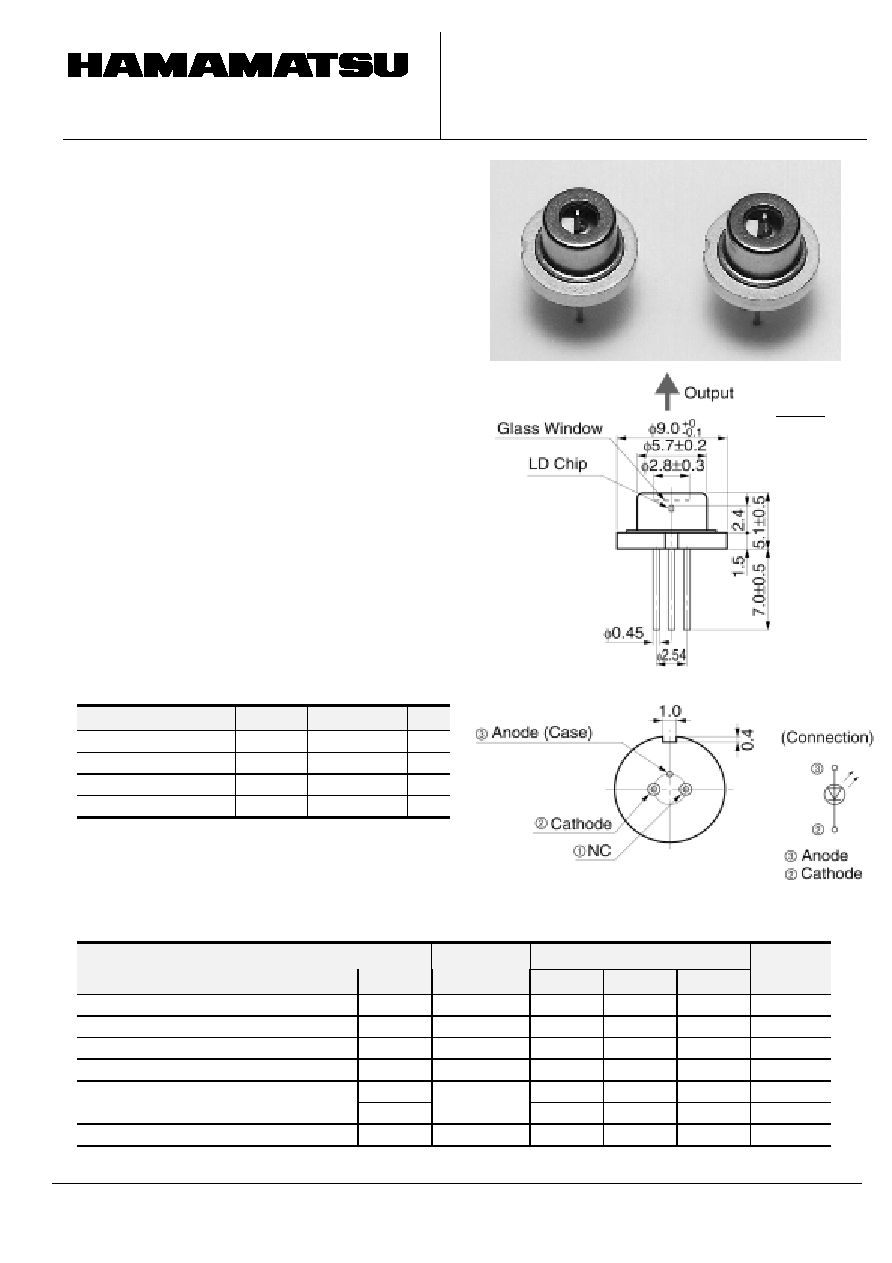
Preliminary Data
Information furnished by HAMAMATSU is believed to be reliable. However, no responsibility is assumed for possible inaccuracies or omissions.
830nm 1W CW Laser Diode
L9277-42
FEATURES:
High output power & high brightness
1W CW Output Power
50m x 1m Emitting Area
Peak Emission Wavelength 830nm +/- 10nm
Multimode
High Stability
Long Life
Compact
APPLICATIONS:
Printing
Medical Instrument
Measuring Instrument
ABSOLUTE MAXIMUM RATINGS
(Top(c)=25)
Parameter
Symbol
Value
Unit
Radiant Output Power
�
e
1.2
W
Reverse Voltage
V
R
2
V
Operating Temperature
Top
(c)
0 to +30
Storage Temperature
Tstg
-30 to +80
Unit:mm
ELECTRICAL AND OPTICAL CHARACTERISTICS
(Top
(c)
=25)
Value
Parameter
Symbol
Condition
Min.
Typ.
Max.
Unit
Forward Current
I
F
�
e
=1W
- 1.2 1.4 A
Peak Emission Wavelength
p
�
e
=1W
820 830 840 nm
Spectral Radiation Half Bandwidth
�
e
=1W
- 2 3 nm
Forward Voltage
V
F
�
e
=1W
- 2 2.4 V
//
4
8
12
degree
Beam Spread Angle : Parallel
: Vertical
�
e
=1W
FWHM
27 32 37
degree
Lasing Threshold Current
Ith
-
-
0.35
0.5
A
Specifications are subject to change without notice. No patent rights are granted to any of the circuits described herein.

830nm 1W CW Laser Diode L9277-42
INSTRUCTIONS FOR SAFETY USE
1. Heat dissipation
Reliability of this LD is deeply correlated with junction temperature. Under higher operating temperature, the reliability deteriorates soon. Heat dissipating device (material: Aluminum, Copper) should be
attached to the base of the LD, and cooling devices (air, water, peltier etc.) should be operated with the LD in order to dissipate the heat from the LD, so that the operating temperature is kept within the
absolute maximum ratings.
2. Safety for operators and users
This LD emits invisible laser radiation. It's classified into Class 4 according to the laser product standards of the IEC 60825-1 (Safety of laser products Part 1 : Equipment classification, requirements and user's
guide) and/or ANSI Z136.1 (American National Standard for Safe Use of Lasers) etc. Direct or reflected laser beam from this LD may damage eyes or skin by being absorbed by cell. The operator must not
stare the emitting area of LD, must avoid direct exposure to the laser beam.
http://www.hamamatsu.com
Apr 2003
HAMAMATSU PHOTONICS K.K. Laser Group, Sales Dept.
5000, Hirakuchi, Hamakita City, Shizuoka, Japan
Telephone: (81)53-584-0227, Fax: (81)53-584-0228, e-mail: laser-g@lsr.hpk.co.jp

